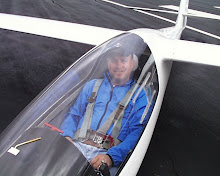Sunday, December 27, 2009
Winglets for the Epic
Monday, December 7, 2009
Soaring in the Alps....
Sunday, December 6, 2009
New pictures added....
Catchup (not ketchup) Time


 I can tell there's not a lot of activity on my blog because no one is reminding me to keep it updated. I have been pretty slow, but finally decided to at least write a few things and post some pictures.
I can tell there's not a lot of activity on my blog because no one is reminding me to keep it updated. I have been pretty slow, but finally decided to at least write a few things and post some pictures.Thursday, May 14, 2009
Wow! What a video!!!!!
Saturday, May 2, 2009
"G" does not stand for glider...

This is a replica of the wings worn by glider pilots of World War II. One pilot of that era remarked, "The G doesn't stand for glider, it stands for guts." Considering the plywood contraptions they flew, and the conditions which they flew in, I would say that he is most certainly correct!
People say the darndest things:
I have been asked many times by the curious and unknowing, "How can you land a plane without an engine?" For the life of me, I can't understand how to land a plane with one.
I have also been asked "Why don't you wear a parachute?" It's not required I replied. But what if you crash? Then I guess I don't need it, do I?
One day I hope to fly powered planes. During my training it would be my supreme joy to cut short my pattern, kill the engine, and perform an unpowered slip to landing, all just to see if my instructor raises an eyebrow.
Monday, April 20, 2009
Tail Mount Camera...
Tuesday, March 31, 2009
Greenbird...Part aeroplane, part sailboat, part Formula One car





The Greenbird team were on stand-by in September 2008 at Lake Lefroy in Western Australia but were unable to run due to unseasonal rain. Jenkins has been chasing his dream of setting the record for 10 years and Greenbird is the fifth version of of the land yacht Jenkins originally called Windjet but renamed in a nod to Bluebird, the record-setting racers Britain's Donal Campbell drove in the 1950s and '60s.
The Greenbird is a 600 kg carbon fiber composite vehicle that uses wind (and nothing else) for power. The only steel in the vehicle is the wheel bearings and bearings used to make the vehicle steerable. The land yacht is a very high performance sailboat that uses a solid wing, rather than a sail, to generate movement. The aerodynamic design and light weight allows the vehicle to achieve speeds three to five times faster than the wind speed thanks to a phenomenon known as ‘apparent wind’.
For an example of apparent wind, imagine you are riding your bicycle on a completely calm day with no wind. You can feel wind on your face and it feels stronger as you pedal faster. That is because as you move forward, the motion creates its own wind. Now imagine you are riding your bicycle but there is a strong breeze coming at you from the right. This natural wind is called "true wind". When you add this side wind to the cycle ride, the wind the rider feels is now somewhere between the true wind (from the side) and the man made wind (from ahead). This resultant wind is know as the ‘apparent wind’ and will have a speed and apparent wind angle, measured from the direction of travel to the apparent wind angle.
Iron Duck, the previous record holder driven by American Bob Schumacher was a similar design and the record was set at the same location. The primary difference between the two is that where Greenbird is all carbon fiber the Iron Duck was steel framed with foam and fibreglass fairings.
Richard Jenkins also has an ice version of the Greenbird so the next challenge is to settle the debate about whether traveling on ice or land will be faster.
Paul Evans
Sunday, March 29, 2009
Lenticular...
Monday, February 23, 2009
Tuesday, February 17, 2009
Saturday, January 3, 2009
Flying in the dead of winter...
Thursday, January 1, 2009
It's been a long time...








